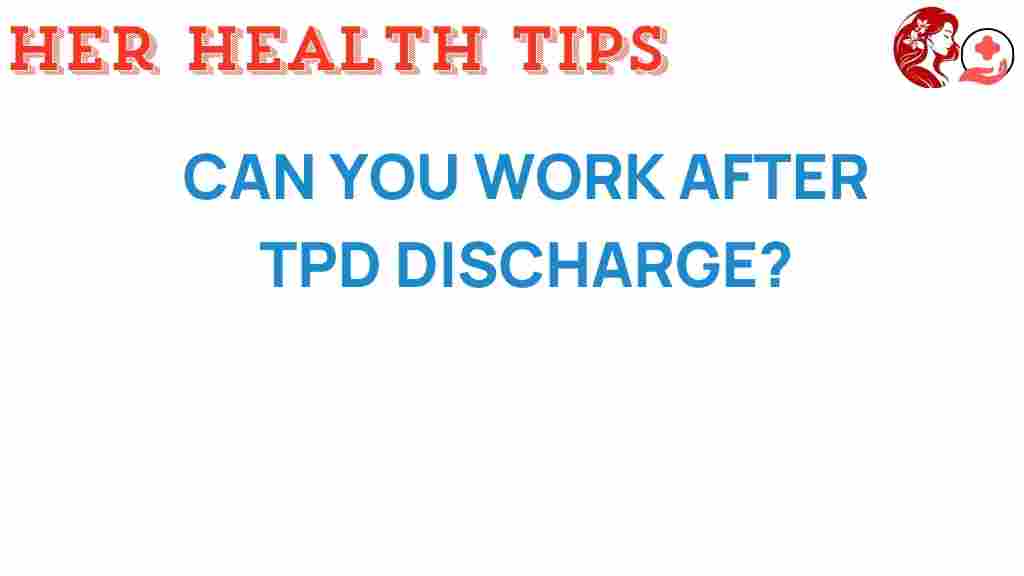The Surprising Truth: Can You Work After TPD Discharge?
If you’ve recently received a Total and Permanent Disability (TPD) discharge, you may be wondering about your options when it comes to employment. Many individuals believe that once they are granted a TPD discharge, they are completely barred from working again. However, the reality is often more nuanced. In this article, we will explore the surprising truth about TPD discharge and employment, the recovery process, and how you can successfully reintegrate into the workforce while still maintaining your disability benefits.
Understanding TPD Discharge
Before delving into the specifics of employment after TPD discharge, it’s essential to understand what TPD discharge entails. A TPD discharge is a forgiveness of federal student loans for individuals who are unable to work due to a permanent disability. This can provide significant financial relief but can also lead to confusion regarding future employment.
Can You Work After TPD Discharge?
The answer is yes! You can work after a TPD discharge. However, there are some important considerations to keep in mind:
- Employment Limits: While you can work, there are income limits that you must adhere to in order to maintain your disability benefits.
- Health Considerations: It’s crucial to prioritize your health and ensure that any work you undertake aligns with your recovery goals.
- Support Systems: Utilize support from healthcare providers, vocational rehabilitation services, or supportive employment programs.
The Benefits of Returning to Work
Reintegrating into the workforce after TPD discharge can be beneficial for several reasons:
- Financial Independence: Earning an income can help you regain financial stability.
- Social Connections: Employment can provide valuable social interactions and reduce feelings of isolation.
- Sense of Purpose: Many individuals find that work gives them a renewed sense of purpose and accomplishment.
Step-by-Step Process for Returning to Work
Returning to work after a TPD discharge requires careful planning. Here’s a step-by-step process to guide you:
Step 1: Assess Your Health
Before considering employment, evaluate your health and recovery status. Consult with your healthcare provider to discuss your readiness to return to work and any limitations you may have.
Step 2: Explore Employment Options
Consider job opportunities that align with your skills and health needs. Look for flexible jobs that allow for part-time work or remote positions. Some options might include:
- Freelance work
- Consulting
- Remote customer service roles
- Nonprofit work
Step 3: Understand Your Benefits
Research how your employment might affect your disability benefits. Some programs allow you to earn a certain amount of income without losing your benefits. It’s important to contact your benefits administrator to clarify these details.
Step 4: Utilize Vocational Rehabilitation Services
Consider enrolling in vocational rehabilitation services. These programs can provide assistance with job placement, skills training, and other resources to help you re-enter the workforce successfully.
Step 5: Start Gradually
When you begin working, start with a manageable number of hours to ensure you can balance your health and employment. Gradually increase your hours as you adjust to the demands of the job.
Troubleshooting Tips for Employment After TPD Discharge
While the process of returning to work can be rewarding, you may encounter challenges along the way. Here are some troubleshooting tips:
- Health Fluctuations: If your health fluctuates, communicate openly with your employer about your needs and seek accommodations when necessary.
- Income Management: Keep track of your earnings to ensure that you stay within any income limits associated with your disability benefits.
- Seek Support: Don’t hesitate to reach out to support groups or counseling services to help you navigate the emotional aspects of returning to work.
Resources for Support
There are various resources available that can provide support during your transition back to work:
- Vocational Rehabilitation Services – State-specific programs that assist individuals with disabilities in finding and maintaining employment.
- Disability Support Groups – Online and local communities where you can connect with others who share similar experiences.
- Your healthcare provider – They can offer guidance tailored to your specific health needs and recovery process.
Conclusion
In conclusion, while TPD discharge can significantly change your financial situation, it does not have to limit your ability to work. By understanding your health, exploring flexible employment options, and utilizing available resources, you can successfully reintegrate into the workforce while maintaining your disability benefits. Remember to prioritize your health and well-being throughout this process. With the right support and planning, you can navigate this transition and find fulfilling employment that accommodates your needs.
For more information on TPD discharge and employment, consider visiting government resources or consulting with a financial advisor who specializes in disability benefits.
This article is in the category Conditions and created by HerHealthTips Team
